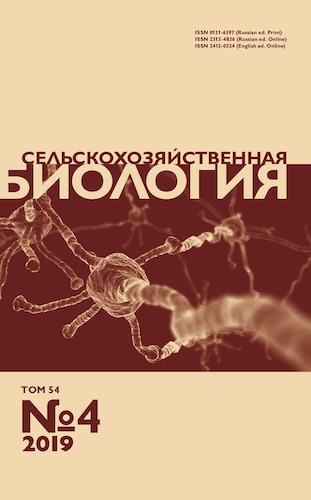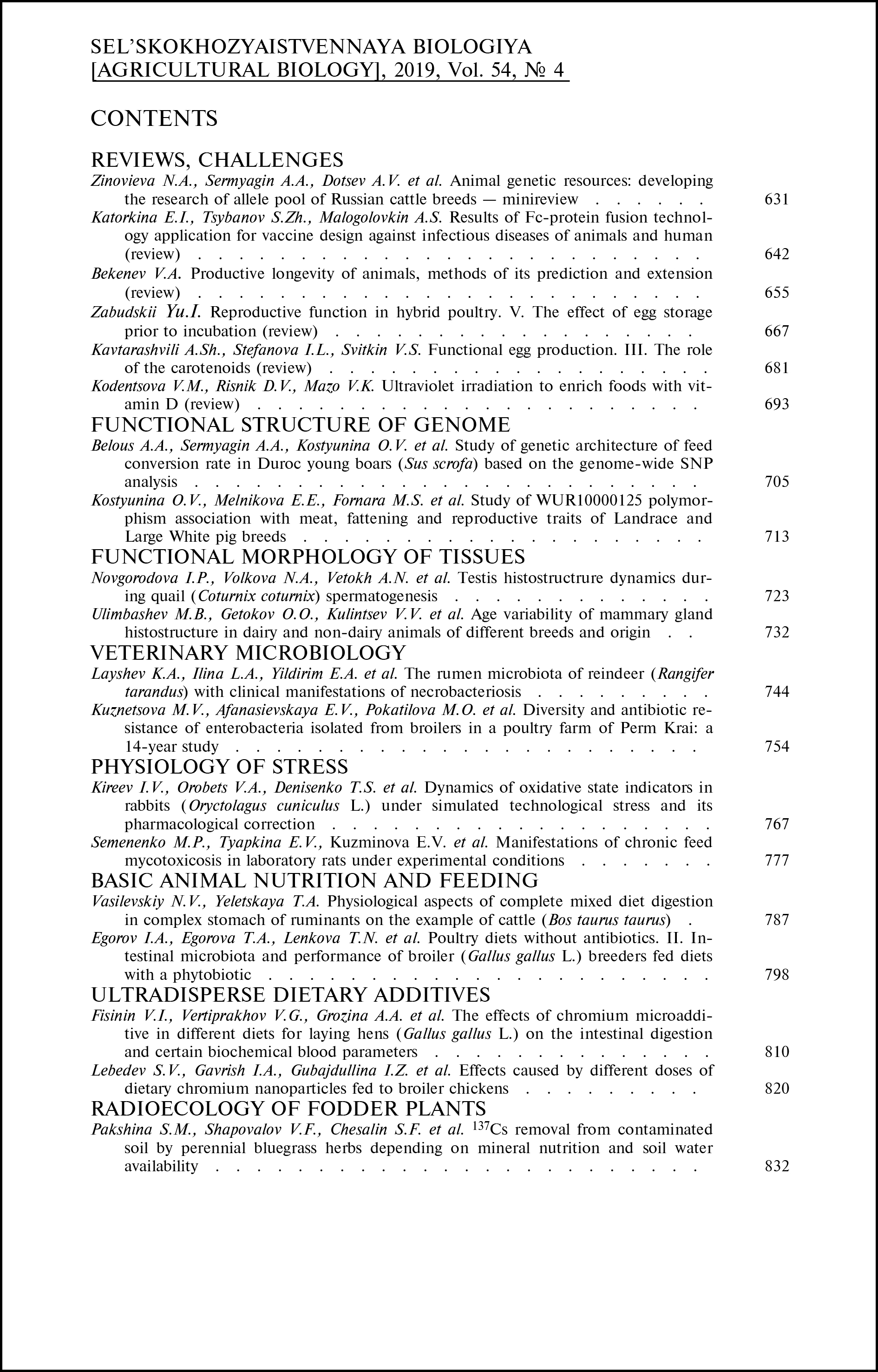doi: 10.15389/agrobiology.2019.4.732eng
UDC: 636.2/.3:636.018:591.469:591.8
AGE VARIABILITY OF MAMMARY GLAND HISTOSTRUCTURE IN DAIRY AND NON-DAIRY ANIMALS OF DIFFERENT BREEDS AND ORIGIN
M.B. Ulimbashev1, O.O. Getokov2, V.V. Kulintsev1, R.A. Ulimbasheva2
1North-Caucasian Federal Scientific Agrarian Center, 49, ul. Nikonova, Mikhailovsk, Stavropol Krai, 356241 Russia, e-mail info@fnac.center, murat-ul@yandex.ru (✉ corresponding author);
2Kokov Kabardino-Balkarian State Agrarian University, 1v, prosp. V.I. Lenina, Nal’chik, Kabardino-Balkarian Republic, 360030 Russia, e-mail getokov777@mail.ru, ulimbasheva1976@mail.ru
ORCID:
Ulimbashev M.B. orcid.org/0000-0001-9344-5751
Kulintsev V.V. orcid.org/0000-0003-2482-6336
Getokov O.O. orcid.org/0000-0001-8252-5246
Ulimbasheva R.A. orcid.org/0000-0003-1755-2672
Received September 25, 2018
Increase in milk production and improvement of milk quality must be addressed, along with of paratypic factors, through further researches of breast morphology and physiology. These studies are targeted not only at its morphological and functional characterization, but also at establishing basis for changing the body's activities and improvement of dairy animals. For most dairy breeds in the process of breeding almost reached the biological threshold of productivity. In addition, with the development of highly mechanized and automated technologies for milk production, the requirements for the selection of animals for adaptation to such conditions, in particular for the state of the udder, have increased. Therefore, an additional reserve can be the improvement of dairy cattle and improve the quality of milk on the basis of in-depth studies of the morphological, functional characteristics and physiology of the breast. The most informative data are presented on the structure and function of the udder in species with high initial milk yield and high quality indicators in comparison to the most common breeds of cattle. In the scientific literature there are no comparative data on histological mammary gland of cows and female-yaks. The results presented by us in this study fill this gap. Investigations of histostructure of udder in cows were carried out on black-motley and Brown Swiss breeds and their crosses with Holsteins (F1 and F2, Lenin APS Farm), and on the local population of Brown Swiss cows and female-yaks imported from Tuva and Kyrgyzstan (LLS “Elbrus Agroinvest” farm). The microstructure was investigated using 2×3 cm2 specimens taken between dairy base and the base of the tank throughout the udder fraction along a line passing through the center of the teat canal and lactic sinus in the right front of teat. In the mammary gland of 1/2 Holstein-Swiss crossbred cows the diameter of alveoli were the largest and reached 119 mm in the cows of the third lactation, which is 6,2-3,7 % higher compared to peers of other groups (P > 0.999). The smallest diameter of the fat cells are in the black-motley cows (68.3 mm) and the largest ones were in Holstein-Swiss crossbred hybrids of the third lactation, the rest of cows take an intermediate position. The greatest increase in the diameter of the fat cells with age was in Holstein × black-motley hybrids F2 in which the figure ranges from 68.6 mm in heifers to 77.3 mm in cows of the third calving. Consequently, according to the development and size of structure elements most important for milk production (the size of the alveoli, and the diameter of the fat globules), the animals improved by Holsteins are superior to the peers of pure Brown Swiss and black-motley cows. It was established that in local Brown Swiss cows the alveoli diameter is higher than that of female-yaks, regardless of their origin, and averages 9.1-11.3 mm. By the fat cell diameter, the female-yaks were superior to the Brown Swiss peers by 4.5-5.4 mm on average. Thus, mammary glands of Brown Swiss cows and female-yaks imported from Tuva and Kyrgyzstan have characteristics features, namely Brown Swiss cows of local population have larger quantity of glandular epithelial cells, the diameter of alveoli, and the thickness of the main strands, whereas female-yaks have a higher concentration of adipose tissue, a smaller diameter of fat cells and the thickness of interlobular strands. For comparison, we compared the mammary gland in another animal species, the goats of different origin. It was shown that the Zaanen breed has better developed mammary gland with higher biomechanical properties as compared to the local goats’ population.
Keywords: cows, yaks, goats, genotype, mammary gland, histological structure, alveoli, adipose cells, connective-woven strands.
REFERENCES
- Guzeev Yu.V. Tekhnologіya virobnitstva і pererobki produktsії tvarinnitstva, 2014, 1(110): 52-57 (in Russ.).
- Klimov N.T., Zimnikov V.I. Molochnaya promyshlennost', 2015, 10: 69-70 (in Russ.).
- Tyshkivska N., Sahnyuk N., Tyshkivskiy M. Naukovi i vіsnikveterinarnoї meditsini, 2015, 2(122): 31-36 (in Russ.).
- Liskun E.F. Trudy Byuro po zootekhnii, 1912, 8: 26-84 (in Russ.).
- Santos D.B., Vanin J., Silva C.G. Milk quality of family farms practicing crop-livestock integration depending on land use. Agr. Brasil. Med. Vet. Zootechn., 2013, 65(4): 1217-1222 CrossRef
- Davydova T.G., Drozdova L.I. Agrarnyi vestnik Urala, 2011, 9(88): 20-22 (in Russ.).
- Van der Zwaag H.G., Van Schaik G., Lam T.J.G.M. Mastitis control program in the Netherlands: goal, tools and conditions. 4th IDF Int. Mastitis Conference. Academic Publishers, Wageningen, the Netherlands, 2005: 599-604.
- Huijps K., Lam T., Hogeveen H. Costs of mastitis: facts and perception. Journal of Dairy Research, 2008, 75: 113-120 CrossRef
- Bar D., Grohn Y.T., Bennett G., Gonzalez R.N., Hertl J.A., Schulte H.F., Tauer L.W., Welcome F.L., Schukken Y.H. Effects of repeated episodes of generic clinical mastitis on mortality and culling in dairy cows. Journal of Dairy Science, 2008, 91(6): 2196-2204 CrossRef
- Shabunin S.V. Uchenye zapiski uchrezhdeniya obrazovaniya Vitebskaya ordena Znak pocheta gosudarstvennaya akademiya veterinarnoi meditsiny, 2017, 53(2): 149-151 (in Russ.).
- Batrakov A.Ya. Uchenye zapiski uchrezhdeniya obrazovaniya Vitebskaya ordena Znak pocheta gosudarstvennaya akademiya veterinarnoi meditsiny, 2011, 47(2): 10-11 (in Russ.).
- Mitev J., Gergovska I., Miteva M. Effect of teat end hyperkeratosis on milk somatic cell counts in Bulgarian Black-and-White dairy cattle. Bulgarian Journal of Agricultural Science, 2012, 18: 451-454.
- Asadpour R., Bagherniaee H., Houshmandzad M., Fatehi H., Rafat A., Nofouzi K., Maftouni K. Relationship between teat end hyperkeratosis with intra mammary infection and somatic cell counts in lactating dairy cattle. Revue de Medecine Veterinaire, 2015, 166: 266-270.
- Kolchina A.F., Barkova A.S., Barashkin M.I. Agrarnyi vestnik Urala, 2012, 12: 12-14 (in Russ.).
- Knight S.H., Wilde C.J. Mammary cell changes during pregnancy and lactation. Livestock Production Science., 1993, 35(1-2): 3-19 CrossRef
- Alvi A.J., Clayton H., Joshi C., Enver T., Ashworth A., Vivanco M.dM, Dale T.C., Smalley M.J. Functional and molecular characterisation of mammary side population cells. Breast Cancer Research, 2003, 5(1): R1-R8 CrossRef
- Smith G.H., Chepko G. Mammary epithelial stem cells. Microsc. Res. Tech., 2001, 52(2): 190-203 CrossRef
- Kordon E.S., Smith G.H. An entire functional mammary gland may comprise the progeny from a single cell. Development, 1998, 125: 1921-1930.
- Esmagambetov K.K. Glavnyi zootekhnik, 2013, 8: 15-19 (in Russ.).
- Suleimanov S.M., Pavlenko O.B., Mironova L.P., Parshin P.A. Aktual'nye voprosy veterinarnoi biologii, 2017, 3(35): 44-49 (in Russ.).
- Besier J., Bruckmaier R.M. Vacuum levels and milk-flow-dependent vacuum drops affect machine milking performance and teat condition in dairy cows. Journal of Dairy Science, 2016, 99(4): 3096-3102 CrossRef
- Edwards J.P., O'Brien B., Lopez-Villalobos N., Jago J.G. Overmilking causes deterioration in teatend condition of dairy cows in late lactation. Journal of Dairy Research, 2013, 80(3): 344-348 CrossRef
- Sterrett A.E., Wood C.L., Mc.Querry K.J., Bewley J.M. Changes in teat-end hyperkeratosis after installation of an individual quarter pulsation milking system. Journal of Dairy Science, 2013, 96(6): 4041-4046 CrossRef
- Ferneborg S., Svennersten-Sjaunja K. The effect of pulsation ratio on teat condition, milk somatic cell count and productivity in dairy cows in automatic milking. Journal of Dairy Research, 2015, 82(4): 453-459 CrossRef
- Rasmussen M.D., de Blom J.Y., Nielsen L.A.H., Justesen P. The impact of automatic milking on udder health. Proceedings of the 2-nd International Symposium on Mastitis and Milk Quality, NMC/AABP. Vancouver, 2001: 397-400.
- Mein G.A., Williams D.M.D., Reinemann J. Effect of milking on teat-end hyperkeratosis: Mechanical forces applied by the teatcup liner and responses of the teat. Proc. 42nd Animal Meeting of the National Mastitis Council. USA, Fort Worth, Texas, 2003: 114-123.
- Götze A., Honnens A., Flachowsky G., Bollwein H. Variability of mammary blood flow in lactating Holstein-Friesian cows during the first twelve weeks of lactation. Journal of Dairy Science, 2010, 93(1): 38-44 CrossRef
- Tuzov I.N., Turlyun V.I. V sbornike: Nauchnye osnovy povysheniya produktivnosti sel'skokhozyaistvennykh zhivotnykh [Scientific basis to increase productivity of farm animals]. Krasnodar, 2009: 130-132 (in Russ.).
- Barmin S.V., Gorbunova N.L., Oleinikova E.V., Solov'eva L.P. Ippologiya i veterinariya, 2011, 2: 89-92 (in Russ.).
- Chikalev A.I., Yuldashbaev Yu.A. Ovtsevodstvo [Sheep breeding]. Moscow, 2015 (in Russ.).
- Gorbunova N.P., Solov'eva L.P. Ippologiya i veterinariya, 2011, 1: 81-83 (in Russ.).
- Shchipakin M.V. Voprosy normativno-pravogo regulirovaniya v veterinarii, 2013, 3: 136-137 (in Russ.).
- Barkova A.S., Shurmanova E.I. Uchenye zapiski uchrezhdeniya obrazovaniya Vitebskaya ordena Znak pocheta gosudarstvennaya akademiya veterinarnoi meditsiny, 2017, 53(2): 166-169 (in Russ.).
- Tamarova R.V. Vestnik APK Verkhnevolzh'ya, 2016, 3(35): 41-47 (in Russ.).
- Tse S., Barkema H.W., DeVries T.J., Rushen J., Pajor E.A. Effect of transitioning to automatic milking systems on producers' perceptions of farm management and cow health in the Canadian dairy industry. Journal of Dairy Science, 2016, 100(3): 2404-2414 CrossRef
- Penry J.F. Mastitis control in automatic milking systems. Veterinary Clinics of North America: Food Animal Practice, 2018, 34(3): 439-456 CrossRef
- Plokhinskii N.A. Rukovodstvo po biometrii dlya zootekhnikov [Biometrics — guide for livestock specialists]. Moscow, 1969 (in Russ.).
- Trzewik Ju., Mallipattu S.K., Artmann G.M., Delano F.A., Schmid-Schonbein G.W. Evidence for a second valve system in lymphatics: endothelial microvalves. The FASEB Journal, 2001, 15(10): 1711-1717 CrossRef












